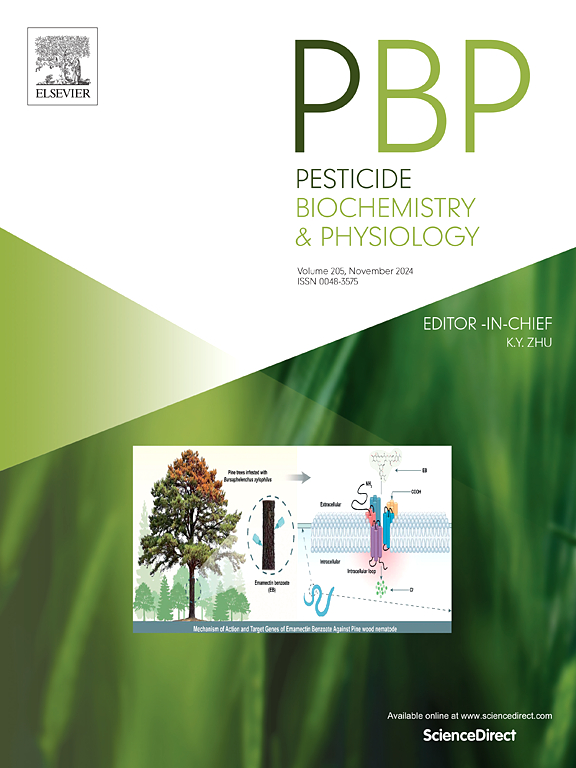The LIM domain protein LmFHL2 is required for nymph-adult metamorphosis of Locusta migratoria
IF 4
1区 农林科学
Q2 BIOCHEMISTRY & MOLECULAR BIOLOGY
引用次数: 0
Abstract
The four-and-a-half LIM domain protein 2 (FHL2) is a conserved transcriptional co-regulator critical for vertebrate development and metabolism, yet its roles in arthropods remain poorly understood. Here, we report the functional characterization of LmFHL2 in the migratory locust Locusta migratoria, a devastating pest reliant on precise molting cycles for growth and swarming. Phylogenetic and expression analyses revealed high conservation of LmFHL2 across insects, with predominant expression in integument and gut tissues. Temporal expression profiling showed that LmFHL2 was primarily expressed during the adult developmental stage. Notably, topical application of juvenile hormone analogue (JHA) to adult locusts resulted in significant upregulation of LmFHL2 expression levels. RNAi-mediated silencing of LmFHL2 resulted in developmental defects in L. migratoria, including molting-associated mortality, reduced body weight, and impaired wing morphogenesis. Histopathological examination showed delayed cuticle formation and disorganized fat body architecture, while integrated multi-omics analyses identified multiple differentially expressed genes and metabolites associated with amino acid, lipid, and carbohydrate metabolism. Mechanistically, knockdown of LmFHL2 disrupted core metabolic pathways—serine hydroxymethyltransferase (SHMT), phosphoenolpyruvate carboxykinase (PCK), and purine nucleoside phosphorylase (PNP), etc.—leading to significant reductions in amino acid, triglycerides, and glycogen content. These findings establish LmFHL2 as a critical regulator of cuticular remodeling and energy-related core metabolic processes during the nymph-to-adult molting transition, providing potential molecular target for pest management strategies.

迁徙蝗的若虫-成虫变态需要LIM结构域蛋白LmFHL2
4 -半LIM结构域蛋白2 (FHL2)是一种保守的转录共调节因子,对脊椎动物的发育和代谢至关重要,但其在节肢动物中的作用仍然知之甚少。在这里,我们报告了LmFHL2在迁徙性蝗虫(Locusta migratoria)中的功能特征,这是一种依赖于精确蜕皮周期生长和成群的破坏性害虫。系统发育和表达分析表明,LmFHL2在昆虫中具有高度保守性,主要表达于被膜和肠道组织。时间表达谱显示LmFHL2主要在成体发育阶段表达。值得注意的是,局部应用稚激素类似物(JHA)对成年蝗虫导致LmFHL2表达水平显著上调。rnai介导的LmFHL2沉默会导致迁徙飞禽的发育缺陷,包括脱毛相关的死亡率、体重减轻和翅膀形态发生受损。组织病理学检查显示角质层形成延迟和脂肪体结构紊乱,而综合多组学分析发现了与氨基酸、脂质和碳水化合物代谢相关的多个差异表达基因和代谢物。从机制上说,LmFHL2的下调破坏了核心代谢途径——丝氨酸羟甲基转移酶(SHMT)、磷酸烯醇丙酮酸羧激酶(PCK)和嘌呤核苷磷酸化酶(PNP)等——导致氨基酸、甘油三酯和糖原含量显著降低。这些发现表明LmFHL2在若虫到成虫蜕皮过程中是表皮重塑和能量相关核心代谢过程的关键调节因子,为害虫管理策略提供了潜在的分子靶点。
本文章由计算机程序翻译,如有差异,请以英文原文为准。
求助全文
约1分钟内获得全文
求助全文
来源期刊
CiteScore
7.00
自引率
8.50%
发文量
238
审稿时长
4.2 months
期刊介绍:
Pesticide Biochemistry and Physiology publishes original scientific articles pertaining to the mode of action of plant protection agents such as insecticides, fungicides, herbicides, and similar compounds, including nonlethal pest control agents, biosynthesis of pheromones, hormones, and plant resistance agents. Manuscripts may include a biochemical, physiological, or molecular study for an understanding of comparative toxicology or selective toxicity of both target and nontarget organisms. Particular interest will be given to studies on the molecular biology of pest control, toxicology, and pesticide resistance.
Research Areas Emphasized Include the Biochemistry and Physiology of:
• Comparative toxicity
• Mode of action
• Pathophysiology
• Plant growth regulators
• Resistance
• Other effects of pesticides on both parasites and hosts.

 求助内容:
求助内容: 应助结果提醒方式:
应助结果提醒方式:


